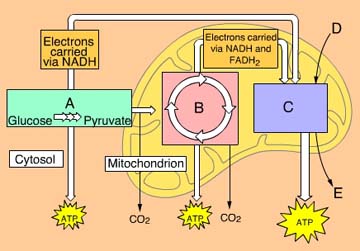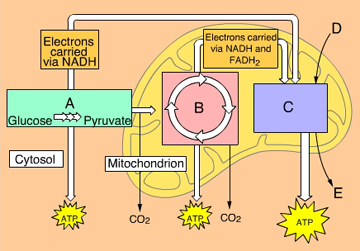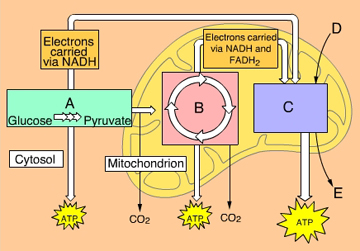 |
| 1 . |
|
What process occurs in Box A? (Activity 6A)  [Hint] [Hint]
|
 |
| 2 . |
|
What process occurs within Box B? (Activity 6A)  [Hint] [Hint]
|
 |
| 3 . |
|
What molecule is indicated by the letter D? (Activity 6A)  [Hint] [Hint]
|
 |
| 4 . |
|
How many NADH are produced by glycolysis? (Activity 6B) [Hint]
|
 |
| 5 . |
|
In glycolysis, ATP molecules are produced by _____. (Activity 6B) [Hint]
|
 |
| 6 . |
|
Which of these is NOT a product of glycolysis? (Activity 6B) [Hint]
|
 |
| 7 . |
|
In glycolysis, energy from _____ starts the process of glucose oxidation. (Activity 6B) [Hint]
|
 |
| 8 . |
|
In glycolysis there is a net gain of _____ ATP. (Activity 6B) [Hint]
|
 |
| 9 . |
|
Which of these enters the Citric Acid Cycle? (Activity 6C) [Hint]
|
 |
| 10 . |
|
How does pyruvate enter a mitochondrion? (Activity 6C) [Hint]
|
 |
| 11 . |
|
In the Citric Acid Cycle, ATP molecules are produced by _____. (Activity 6C) [Hint]
|
 |
| 12 . |
|
Which of these is NOT a product of the Citric Acid Cycle? (Activity 6C) [Hint]
|
 |
| 13 . |
|
For each glucose that enters glycolysis, _____ acetyl CoA enter the Citric Acid Cycle. (Activity 6D) [Hint]
|
 |
| 14 . |
|
For each glucose that enters glycolysis, _____ NADH + H+ are produced by the Citric Acid Cycle. (Activity 6D) [Hint]
|
 |
| 15 . |
|
In cellular respiration, most ATP molecules are directly produced by _____. (Activity 6D) [Hint]
|
 |
| 16 . |
|
The final electron acceptor of cellular respiration is _____. (Activity 6D) [Hint]
|
 |
| 17 . |
|
During electron transport, energy from _____ is used to pump hydrogen ions into the _____. (Activity 6D) [Hint]
|
 |
| 18 . |
|
Structure A is _____. (Activity 6D)  [Hint] [Hint]
|
 |
| 19 . |
|
ATP synthase uses _____ to add a phosphate to ADP. (Activity 6D) [Hint]
|
 |
| 20 . |
|
In muscle cells, fermentation produces _____. (Activity 6E) [Hint]
| | pyruvate (pyruvic acid) |
| | carbon dioxide, ethanol, NAD+, and ATP |
| | carbon dioxide, ethanol, NADH, and ATP |
| | carbon dioxide, lactate (lactic acid), NAD+, and ATP |
| | carbon dioxide, lactate (lactic acid), NADH, and ATP |
|
 |
| 21 . |
|
In fermentation _____ is reduced and _____ is oxidized. (Activity 6E) [Hint]
|
 |
|